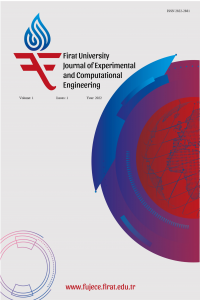Investigation of some thermophysical properties of Asphodelus aestivus reinforced polyester composite
Investigation of some thermophysical properties of Asphodelus aestivus reinforced polyester composite
Polyester composite, Biomass, Density, Hardness Thermal conductivity, Activation energy,
___
- [1] Orhan R, Aydoğmuş E, Topuz S, Arslanoğlu H. “Investigation of thermo-mechanical characteristics of borax reinforced polyester composites”. Journal of Building Engineering. 42, 103051, 2021.
- [2] Aydoğmuş E, Arslanoğlu H, Dağ M. “Production of waste polyethylene terephthalate reinforced biocomposite with RSM design and evaluation of thermophysical properties by ANN”. Journal of Building Engineering, 44, 103337, 2021.
- [3] Aydoğmuş E, Arslanoğlu H. “Kinetics of thermal decomposition of the polyester nanocomposites”. Petroleum Science and Technology, 39(13–14), 484–500, 2021.
- [4] Aydoğmuş E. “Biohybrid nanocomposite production and characterization by RSM investigation of thermal decomposition kinetics with ANN”. Biomass Conversion and Biorefinery, 2022.
- [5] Aydoğmuş E, Dağ M, Yalçın Z G, Arslanoğlu H. “Synthesis and characterization of waste polyethylene reinforced modified castor oil‐based polyester biocomposite”. Journal of Applied Polymer Science, 139, e525256, 2022.
- [6] Demirel MH, Aydoğmuş E. “Production and Characterization of Waste Mask Reinforced Polyester Composite”. Journal of Inonu University Health Services Vocational School. 10(1), 41-49, 2022.
- [7] Demirel MH, Aydoğmuş E. “Waste Polyurethane Reinforced Polyester Composite, Production and Characterization”. Journal of the Turkish Chemical Society Section A: Chemistry. 9(1), 443–452, 2022.
- [8] Yanen C, Aydoğmuş E. “Characterization of Thermo-Physical Properties of Nanoparticle Reinforced the Polyester Nanocomposite”. Dicle University Journal of the Institute of Natural and Applied Science. 10(2), 121–132, 2021.
- [9] Yanen C, Dağ M, Aydoğmuş E. “Investigation of Thermophysical Properties of Colemanite, Ulexite, and Tincal Reinforced Polyester Composites”. European Journal of Science and Technology, 36, 155–159, 2022.
- [10] Şahal H, Aydoğmuş E. “Investigation of Thermophysical Properties of Polyester Composites Produced with Synthesized MSG and Nano-Alumina”. European Journal of Science and Technology, 34, 95-99, 2022.
- [11] Orhan R, Topuz S, Aydoğmuş E. “Experimental and Theoretical Study on Mechanical Properties of Apricot Stone Shell Reinforced Polyester Composites”. 3. Asia Pacific International Congress on Contemporary Studies, South Korea, 2020.
- Başlangıç: 2022
- Yayıncı: Fırat Üniversitesi
Determination of water sensitivity of nanosilica added hot mix asphalt
Tacettin GEÇKİL, Ceren Beyza İNCE, Eda Tüzün ÖZPINAR
Classification of recyclable waste using deep learning architectures
Iredia Davis ERHUNMWUN, Mohammed Idaomi SALIU, Patrick Ejebheare AMIOLEMHEN
Failure mechanism of a soil slope and stabilization method: a case study
